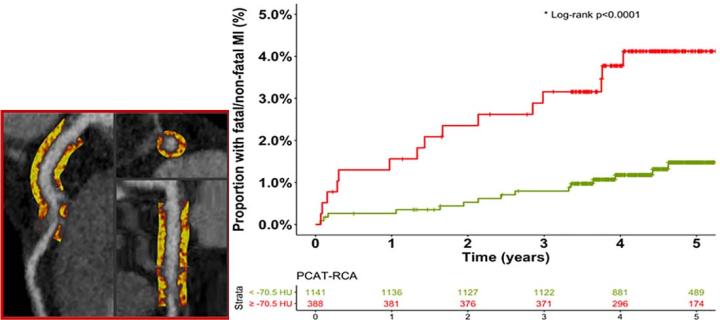03 Oct 21. SCS Best Scientific Abstract award
Congratulations to Dr Evangelos Tzolos for receiving the Best Scientific Abstract award for work on pericoronary adipose tissue attenuation at the SCS 30th annual meeting.

Dr Evangelos Tzolos, Clinical Research Fellow presented work on pericoronary adipose tissue attenuation at the recent virtual Scottish Cardiac Society 30th Annual General Meeting.
The presentation, “Pericoronary adipose tissue attenuation, low attenuation plaque burden & 5-year risk of myocardial infarction” received the Best Scientific Abstract award.
Evangelos explains: pericoronary adipose tissue (PCAT) attenuation has emerged as a surrogate marker of pericoronary inflammation. In a post-hoc analysis of SCOT-HEART, we investigated the association between the future risk of fatal or non-fatal myocardial infarction & PCAT attenuation measured from CT coronary angiography.
PCAT attenuation was higher in patients who suffered a myocardial infarction (-72.5±8.3 HU versus -76.5± 7.8 HU, p=0.0063), but there was no difference in PCAT-LAD (-76.3±8.6 HU vs -77.0±7.8 HU, p=0.54) or PCAT-LCx(-71.6±7.3 HU vs -73.3±7.7 HU, p=0.33)., the optimal cut-off of the right coronary artery PCAT attenuation was –70.5 HU for the primary endpoint of fatal or non-fatal myocardial infarction.
Patients with PCAT above ≥–70.5 HU were nearly 2.5 times more likely to suffer a myocardial infarction (HR 2.45, 95% CI 1.23 to 4.80; p=0.001). Patients with low-attenuation plaque burden (greater than 4%) were nearly 5 times more likely to suffer a myocardial infarction (HR 4.87, 95% CI 2.03 to 11.78, p<0.0001).
When the two metrics were combined, patients with both low-attenuation plaque burden >4% & PCAT-RCA ≥-70.5 HU were at the greatest risk of myocardial infarction (HR 11.7, 95% CI 3.3 to 40.9, p<0.0001. CT coronary angiography defined PCAT attenuation & low-attenuation plaque have marked & additive predictive value for the risk of fatal or non-fatal myocardial infarction.
We asked Dr Evangelos Tzolos his thoughts on receiving the award.
“We are really grateful for this award. We would like to thank the Scottish Cardiology Society for the honor.
Our results emphasize the importance of developing novel imaging biomarkers that can enhance risk stratification of patients with coronary artery disease. PCAT is a promising marker that may hopefully help us provide better treatment to our patients.”
Related links
- Dr Evangelos Tzolos
- Scottish Cardiac Society (SCS)
- Scottish Cardiac Society 30th Annual General Meeting
- Heart / cardiovascular
- Coronary artery disease
- SCOT-HEART study
- What is a CT scan?
- 02 Sep 21. ESC Young Investigators Award
- 10 Aug 21. BCS 2021 abstract award
- 18 May 21. JACC Parmley Prize
- 12 Apr 21. BHF Clinical Research Training Fellowship
Social media tags & titles
Congratulations to Dr Evangelos Tzolos for receiving the Best Scientific Abstract award for work on pericoronary adipose tissue attenuation at the SCS 30th annual meeting.
@TzolosEvangelos @EdinUniCVS @ScotCardio @BHFScotland @MarcDweck @imagingmedsci
#SCS2021

